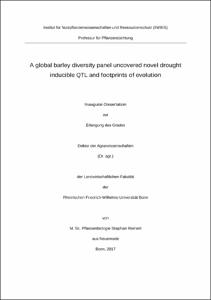Reinert, Stephan: A global barley diversity panel uncovered novel drought inducible QTL and footprints of evolution. - Bonn, 2017. - Dissertation, Rheinische Friedrich-Wilhelms-Universität Bonn.
Online-Ausgabe in bonndoc: https://nbn-resolving.org/urn:nbn:de:hbz:5n-46685
Online-Ausgabe in bonndoc: https://nbn-resolving.org/urn:nbn:de:hbz:5n-46685
@phdthesis{handle:20.500.11811/7012,
urn: https://nbn-resolving.org/urn:nbn:de:hbz:5n-46685,
author = {{Stephan Reinert}},
title = {A global barley diversity panel uncovered novel drought inducible QTL and footprints of evolution},
school = {Rheinische Friedrich-Wilhelms-Universität Bonn},
year = 2017,
month = mar,
note = {The fibrous root system is a visible sign of ecological adaptation among barley natural populations. In the present study, we utilized rich barley diversity to dissect the genetic basis of root system variation and its link with shoot attributes under well-water and drought conditions. Therefore, we analyzed five root and related shoot traits: root dry weight, root length, root-shoot ratio, shoot dry weight and number of tillers. Genome-wide association mapping of phenotype data using a dense genetic map (5892 SNP markers) revealed 17 putative quantitative trait loci (QTL) for these root and shoot traits. Among these, at 14 loci the preeminence of exotic QTL alleles resulted in trait improvements. The most promising QTL were quantified using haplotype analysis at local and global genome levels. The strongest QTL was found on chromosome 1H which accounted for root dry weight and tiller number simultaneously. Candidate gene analysis across the targeted region detected a crucial amino acid substitution mutation in the conserved domain of a WRKY29 transcription factor among genotypes bearing major and minor QTL alleles. Similarly, the drought inducible QTL QRdw.5H (5H, 95.0 cM) seems to underlie 37 amino acid deletion and substitution mutations in the conserved domain of two related genes CBF10B and CBF10A, respectively. The identification and further characterization of these candidate genes will be essential to decipher genetics behind developmental and natural adaptation mechanisms of barley.
Further, we analyzed the population to detect evolutionary footprints within the global barley diversity set. Therefore, we performed a loci outlier analyzes using the outlier detection tool BayeScan with the dense genetic map (5892 SNP marker) on three detected subpopulations (SPOPs). The analysis resulted in one outlier locus among the three SPOPs on barley chromosome 2H. A sequence analysis of the candidate gene revealed a crucial point mutation within the coding sequence (CDS) which leads to a truncated protein. Moreover, the mutation showed a SPOP-based as well as subspecies-based pattern. Furthermore, a detailed phenotypic analysis of this mutation in near isogenic lines (NIL) revealed a putative function of the candidate gene in shoot development. Further characterization of this candidate gene will gain a better insight in the differences in shoot development between Hordeum vulgare ssp. spontaneum (wild barley) and Hordeum vulgare ssp. vulgare (cultivated barley).},
url = {https://hdl.handle.net/20.500.11811/7012}
}
urn: https://nbn-resolving.org/urn:nbn:de:hbz:5n-46685,
author = {{Stephan Reinert}},
title = {A global barley diversity panel uncovered novel drought inducible QTL and footprints of evolution},
school = {Rheinische Friedrich-Wilhelms-Universität Bonn},
year = 2017,
month = mar,
note = {The fibrous root system is a visible sign of ecological adaptation among barley natural populations. In the present study, we utilized rich barley diversity to dissect the genetic basis of root system variation and its link with shoot attributes under well-water and drought conditions. Therefore, we analyzed five root and related shoot traits: root dry weight, root length, root-shoot ratio, shoot dry weight and number of tillers. Genome-wide association mapping of phenotype data using a dense genetic map (5892 SNP markers) revealed 17 putative quantitative trait loci (QTL) for these root and shoot traits. Among these, at 14 loci the preeminence of exotic QTL alleles resulted in trait improvements. The most promising QTL were quantified using haplotype analysis at local and global genome levels. The strongest QTL was found on chromosome 1H which accounted for root dry weight and tiller number simultaneously. Candidate gene analysis across the targeted region detected a crucial amino acid substitution mutation in the conserved domain of a WRKY29 transcription factor among genotypes bearing major and minor QTL alleles. Similarly, the drought inducible QTL QRdw.5H (5H, 95.0 cM) seems to underlie 37 amino acid deletion and substitution mutations in the conserved domain of two related genes CBF10B and CBF10A, respectively. The identification and further characterization of these candidate genes will be essential to decipher genetics behind developmental and natural adaptation mechanisms of barley.
Further, we analyzed the population to detect evolutionary footprints within the global barley diversity set. Therefore, we performed a loci outlier analyzes using the outlier detection tool BayeScan with the dense genetic map (5892 SNP marker) on three detected subpopulations (SPOPs). The analysis resulted in one outlier locus among the three SPOPs on barley chromosome 2H. A sequence analysis of the candidate gene revealed a crucial point mutation within the coding sequence (CDS) which leads to a truncated protein. Moreover, the mutation showed a SPOP-based as well as subspecies-based pattern. Furthermore, a detailed phenotypic analysis of this mutation in near isogenic lines (NIL) revealed a putative function of the candidate gene in shoot development. Further characterization of this candidate gene will gain a better insight in the differences in shoot development between Hordeum vulgare ssp. spontaneum (wild barley) and Hordeum vulgare ssp. vulgare (cultivated barley).},
url = {https://hdl.handle.net/20.500.11811/7012}
}






